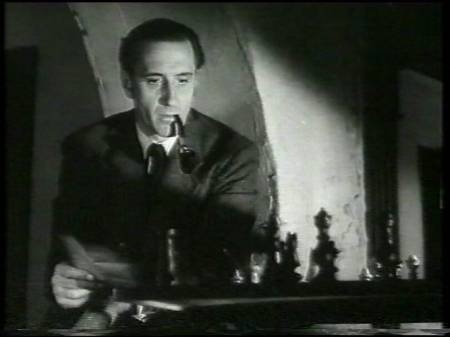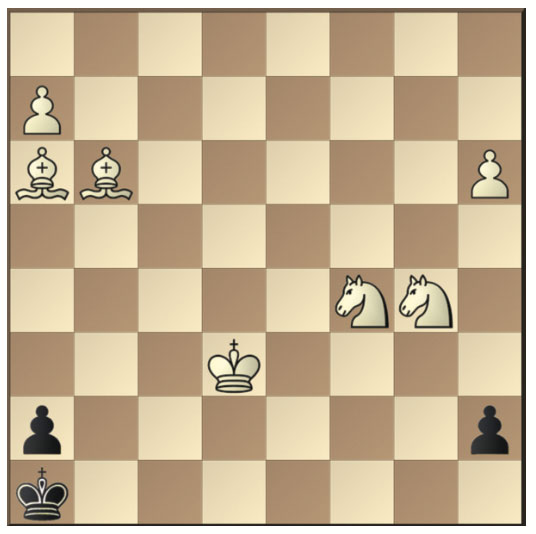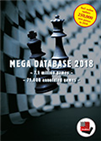Study of the Month: July, 2018
The classical tales offer a lot of promising and fulfilling stories, be it the German fairytale classics as collected by the Grimm brothers or the autobiographical satirical tales told by Baron Münchhausen, be it the supposed Arabian tales of Sheherazade, be it modern literature such as the mystic Arthur Conan Doyle’s detectives Sherlock Holmes and Dr. Watson.
With the exception of the Grimm collection, the abovementioned tales were used as a base for retellings or reimaginings in chess books. Josef Krejcik’s satirical tales have to be mentioned shortly as well, even as they were original or based on chess events, such as the world chess championship, making it not too appropriate for this month which handles the retelling of classical fiction.
Raymond Smullyan (1921-2017) wrote two interesting books of which I own only one. The earlier, other one is Chess Mysteries of the Arabian Knights, based on the Sheherazade story: The king, betrayed by his first wife, is known to always kill his new wife after their night together, marrying another one each day, and as the vizir’s daughter Sheherazade is his wife, she knows about this. To stop the killing she begins to spin a fairy tale, and leaves on a cliffhanger as morning dawns and there is no more time to tell the end. Of course, if she dies, the king will never know the end of the story, so she lives for another day. She finishes the story the next night and starts another one. This goes on for a thousand and one nights, until finally the king abandons his plan and stays with her.
Arthur Conan Doyle’s famous detective Sherlock Holmes and his companion Dr. Watson are known for solving crime mysteries, having been adapted later into various formats, including several re-interpretations in television. Based on the original stories, Smullyan published a book that contains retro problems, including those on a monochromatic chess game, that is a game where all pieces have remained on squares of the color they start upon, meaning also that knights can’t move at all as they change that color each turn. One of those serves to illustrate a physical law and we leave it here for the readers to solve: “In the position wKe1 Pd2 Pf2 bKe8, White has an additional bishop on e3 or e4. No piece has ever entered a square of a different color than its starting square. Is the bishop on e3 or e4?”
Of course, the story is developed with many such puzzles, ranging from easy to hard, whereas the necessary knowledge is given to the reader. One curious case has Dr. Watson solve the problem of a missing piece immediately while Sherlock is still thinking about how the position came to pass. On a chess position, one piece was removed, and the question is, which one it was. Sherlock Holmes does a retroanalytical approach while Watson quickly notes that White is missing his king, which must be the missing piece then...
Smullyan’s work includes also numerous non-chess puzzles, such as a logic puzzle known as “The hardest logic puzzle ever”. He returned to the Sheherazade story with his non-chess puzzle book The Riddle of Sheherazade in 1995.
Amatzia Avni has taken the likely fictional stories of the German aristocrat Baron von Münchhausen and worked them into his chess book The Amazing Chess Adventures of Baron Munchausen in 2011. I took the liberty of mentioning this figure in an EG article (“Chess Christmas Carol”, EG January 2017) as “old friend” of Avni, but sadly don’t have the book, so the famous Israeli composer provided a sample for me. The story is called “Half a board and a handful of pieces”. In it, Munchausen has an encounter on a train where he wants to play chess, but they have only some pieces, no board and a handful of cookies of which they can make squares — enough for half a board. They have only a white rook, but manage to paint it black later with chocolate. One of the two positions in the short story is reproduced below, based on the final of a study by Manvelyan, Kralin 55 JT 2000. You can find said study at the end of the article, which is our study of the month.
Avni also shared some of his favorite stories in an article "Are you sitting comfortably?", which appeared in the English magazine CHESS in the January 2017 issue. Thankfully, he sent me a copy of said article. The story of King Charles XII vs. C.H. Grothusen at Bender appeared in many different forms. Sam Loyd composed four mate problems with similar positions, ranging from mate in three to mate in six moves. The first three are given in that story, sometimes also the fourth when the players whose pieces were shot away by bullets of the Turkish army besieging them manage to find one of the pieces and put it back on the board.
Raymond Smullyan offered a story about a spy in disguise in his “Chess Mysteries of the Arabian Knights”. The story of Chris Depasquale — in my own words — is given with the studies at the end of this article. A story of two players disagreeing on a position is given on a Charles Michael Bent study, the study being similar to Gijs van Breukelen’s "taxi study", the (likely fictional) accompanying story for the taxi study of Max Euwe having shown it in a taxi also served as inspiration to my "Chess Christmas Carol" mentioned above.
 Yuri Dorogov’s story mentioned in the Avni article is too funny to not retell quickly here. It's white to play and win (see diagram):
Yuri Dorogov’s story mentioned in the Avni article is too funny to not retell quickly here. It's white to play and win (see diagram):
An alien came to Earth, learning chess. His teacher Yuri Dorogov won a lot of material and the diagrammed position emerged. Dorogov decided to mate in two with 1.Kc2, but having not taught the promotion rules thoroughly backfired now, as the cunning alien replied with 1...h1=K!
Indeed, now 2.Bd4 is mate for one king but stalemate for the other, so it is only a draw. Dorogov, however, exploited his mistake to his advantage and played the incredible move 2.a8=bK (see diagram), moving his pawn to a8 and promoting into a black king!
The alien had only one move 2...Kb8 and Dorogov won after all with 3.h7 Ka8 4.h8Q###, a triple checkmate.
Avni’s exploration ends with the famous Excelsior — not the one by Sam Loyd, but by Vladimir Korolkov, recreating the Longfellow poem in a study.
Before we close the article, let me mention an interesting thematic tourney held a quarter of a century ago: The Hans Klüver Memorial Tourney 1990-1993 featured, in its section B, joke chess problems. The shared first to second prize was one of the favorites of your author, a charming story by Barry P. Barnes: “Sherlock Holmes travels to Rotterdam”.
Holmes and Watson have finished the adventure of "The Final Problem" and travel from Switzerland back to London. Thereby they travel through Germany and the Netherlands to Rotterdam where they want to visit a chess meeting. In the train, still in Germany, after showing their tickets, they find a note with a helpmate in their cabin, given in text: wKa8 Bg5, h7, bKd8, Be7 - h#2, 1.Ke8 (Note: In helpmates Black moves first and is given first in notation, i.e. White and Black have their notation reversed.)
They build the positions on the board. Holmes is confused as the solution for the first problem seems to be 1.Kc8 Bf4 2.Bd8 Bf5 mate. With a white king on b5 instead a8 there would be the solution 1.Ke8 Kc6 2.Bf8 Bg6 mate. Holmes falls asleep.
He wakes up later when in the Netherlands they are controlled again, having to show their tickets. Then they find a note with the second problem in text: wKc4, Pa6, bKc8, Pc5, c6, c7 - h#3, 1.Kb7
Of course moving into check with 1.Kb7 is impossible. Holmes finds the solution 1.Kb8 a7+ 2.Kb7 K:c5 3.Ka6 a8Q mate.
Finally it dawns on Holmes. Watson builds up the first position again. But Holmes corrects him, mentioning that in German “B” does not stand for "bishop" but for "Bauer" — the pawn. So the position is built up again but with pawns instead of bishops:
Now the solution works (in extended German notation): 1.Ke8! Bg6 2.Kf8 Bh8=Q mate.
But what about the other problem? It was found in the Netherlands where “P” is not the pawn but “paard” — the horse, or rather the knight. And the given solution works here also (in Dutch notation): 1.Kb7! K:c5 2.Ka8 Kb6 3.Pb8 Pc7 mate.
They come to the conclusion that the ticket controller was involved in the plot, letting the notes fall while controlling. The letters B and P could be misinterpreted, leading them to the conclusion that someone is expecting them in Rotterdam who knows chess problems well. I quote Holmes’ conclusion from the Barnes story:
"The clue is there. B is for Bishop and Bauer - P is for Pawn and Pard... BP. My guess is that the English problemist B. P. Barnes is the composer. He is capable of such diverting deception, and he is bound to be at the Rotterdam meeting."
You can replay the Barnes problem below. Let us know other great fictional chess stories in the comments, and if enough interest is there we might make an extra article dedicated to retelling some.
 The "Mega" is the database every serious chessplayer needs. The database contains 7.1 million games from 1500 to 2017, in highest quality standard, full of top level analyses and completely classified.
The "Mega" is the database every serious chessplayer needs. The database contains 7.1 million games from 1500 to 2017, in highest quality standard, full of top level analyses and completely classified.You probably know that you can move pieces on our replay boards to analyse and even start an engine to help you. You can maximize the replayer, auto-play, flip the board and even change the piece style in the bar below the board.
At the bottom of the notation window on the right there are buttons for editing (delete, promote, cut lines, unannotate, undo, redo) save, play out the position against Fritz and even embed the ChessBase game viewer on your website or blog. Hovering the mouse over any button will show you its function.

World Federation for Chess Composition (www.wfcc.ch)
Links



















 Yuri Dorogov’s story mentioned in the Avni article is too funny to not retell quickly here. It's white to play and win (see diagram):
Yuri Dorogov’s story mentioned in the Avni article is too funny to not retell quickly here. It's white to play and win (see diagram):






